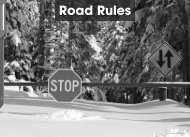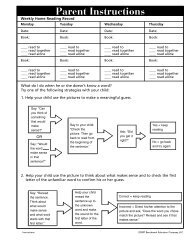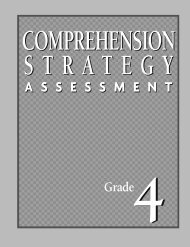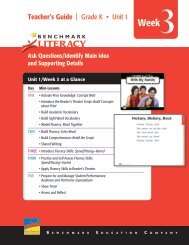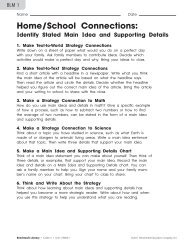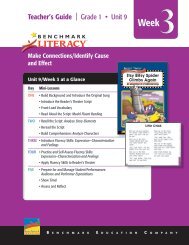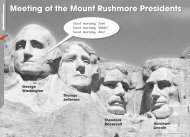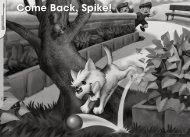Literacy - Benchmark Resources - Benchmark Education Company
Literacy - Benchmark Resources - Benchmark Education Company
Literacy - Benchmark Resources - Benchmark Education Company
Create successful ePaper yourself
Turn your PDF publications into a flip-book with our unique Google optimized e-Paper software.
Day FourMake Content Comprehensiblefor ELLsBeginningAllow ELLs to participate through activelistening while other students demonstratefull stop pausing. Invite them to raise theirhands when they hear a full stop.Intermediate and AdvancedAllow ELLs to echo-read parts of the scriptwith you as they demonstrate their abilityto come to a full stop and then continuereading smoothly.BLM 2Name<strong>Benchmark</strong> <strong>Literacy</strong> • Grade K • Unit 3/Week 3DateFluency Self-Assessment Master ChecklistSpeed/PacingDid my speed and pacing match the kind of text I was reading?Did my speed and pacing match what the character was saying?Did I read with a natural talking voice?Did I slow my reading down when appropriate?Did I pay attention to punctuation?PausingDid I pause to keep from running all my words together?Did I pause in the correct locations?Did I pause for the appropriate length of time?Did I pause to help my reading make sense?Did I use punctuation to help me figure out when to pause?Inflection/IntonationDid I make my voice rise at a question mark?Did I make my voice fall at a period?Did I think about what the author was saying so I would know whento read louder or softer?Did I think about what the author was saying so I would know whento stress or emphasize words?PhrasingDid I notice the phrases?Did I read all the words in each phrase together?Did I think about what the words in the phrase mean when they aretogether?ExpressionDid I look for clues so I could anticipate the mood of the passage?Did I use my tone of voice, facial expressions, and body language toexpress what the author or characters were thinking or feeling?Did I change my reading when something new was about to happen?IntegrationDid I read the words right? (accuracy)Did I read the words at the right speed? (rate)Did I read with expression? (prosody)Did my reading sound like talking?Did I understand what I read?Fluency Self-Assessment MasterChecklist (BLM 2)sS©2010 <strong>Benchmark</strong> <strong>Education</strong> <strong>Company</strong>, LLCResponsive Prompts for Speed and PacingAs students work together, observe those who demonstrate understandingand those who struggle. Use appropriate responsive prompting to provideadditional support or to validate students who demonstrate mastery.Goal Oriented• Listen to me read this. Can you hear me take a little breath at the semicolon?• The period (exclamation point) means your voice makes a full stop.• When I make a short pause, I don’t stop completely and break the flow ofmy reading.• When I finish a sentence, I make a full stop before continuing with my reading.• Notice what I do when I see a semicolon. My reading pauses briefly andthen continues to help make ideas clear as I read.• Notice what I do when I see a(n) period (exclamation point). My readingpauses with a full stop to show that I’ve read a complete sentence or idea.Directive and Corrective Feedback• Make a full stop at the period (exclamation point).• Take a little breath when you see a semicolon.• Read the punctuation.• Read it like this with a short pause between the words.• Read it like this with a full stop after the word.• Make your pause longer.• Maker your pause shorter.Self-Monitoring and Reflection• How did you know to make a short pause here?• How did you know to make a full stop here?• Did you have any trouble knowing where to make a short pause or fullstop as you read?• Was your pausing too short, too long, or just right?• Where did you make short pauses as you read?• Where did you make full stops as you read?Validating and Confirming• Good—you took a little breath.• Good—you made a full stop.• I like the way you made a short pause/full stop here.• I like the way you used the punctuation mark to help you make ashort pause/full stop here.• Good—you used punctuation marks to help you know when to pause andfor how long!12<strong>Benchmark</strong> <strong>Literacy</strong> • Grade K • Unit 3/Week 3©2011 <strong>Benchmark</strong> <strong>Education</strong> <strong>Company</strong>, LLC



